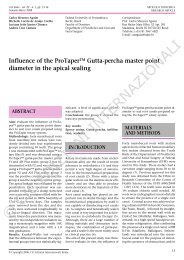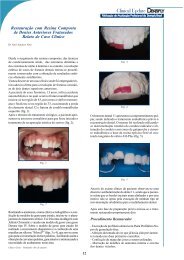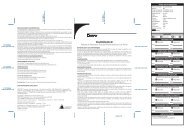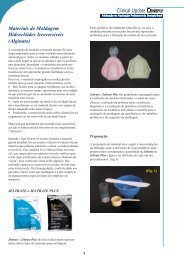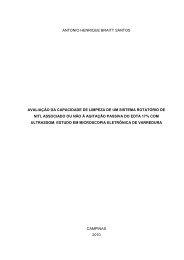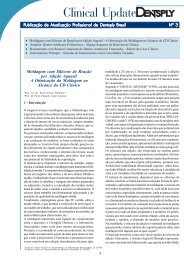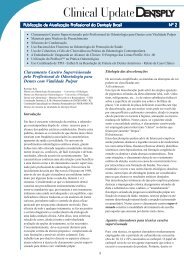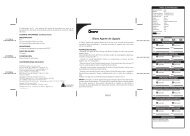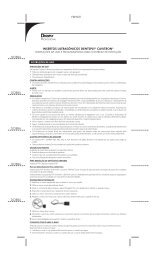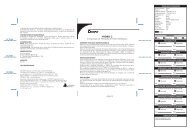You also want an ePaper? Increase the reach of your titles
YUMPU automatically turns print PDFs into web optimized ePapers that Google loves.
Blunck et al<br />
Table 2 Results of the clinical assessment in% of the modified USPH criteria<br />
Criteria for XP BOND [%] Adper Scotchbond 1XT [%]<br />
evaluated<br />
restorations n alpha bravo charlie delta n alpha bravo charlie delta<br />
Retention 38 100 0 0 0 38 97.4 0 0 2.6<br />
Postoperative 38 97.4 2.6 0 0 37 94.6 5.4 0 0<br />
sensitivity (∑)<br />
Marginal 38 100 0 0 0 37 94.6 5.4 0 0<br />
discoloration<br />
Marginal 38 100 0 0 0 37 100 0 0 0<br />
integrity<br />
Secondary 38 100 0 0 0 37 100 0 0 0<br />
caries<br />
Restoration 38 100 0 0 0 37 100 0 0 0<br />
contour<br />
Vitality test 38 100 0 0 0 37 100 0 0 0<br />
tion. A variety of factors, such as the nutrition of the patient,<br />
parafunction, chewing habits, oral hygiene etc, modify the<br />
dentin surface such that the morphology and microstructure<br />
are different compared to surfaces that are exposed during<br />
cavity preparation. 12 Thus, tubules of cervical dentin are exposed<br />
to the oral environment for a longer period and are frequently<br />
partially or totally occluded with precipitates. This<br />
forms a hypermineralized dentin layer that has been found<br />
to be more resistant to etching. 4,10 As a result, a thinner hybrid<br />
layer is formed on the surface, which is different from<br />
the situation in noncervical, cut dentin. 12 It has been shown<br />
that the etch-and-rinse technique results in higher bond<br />
strengths than self-etching adhesive systems. 11 However,<br />
etching dentin with phosphoric acid involves a sensitive<br />
step, namely, the careful drying of the exposed collagen network.<br />
5 This network has to be penetrated completely when<br />
the adhesive system is applied. The results of this study suggest<br />
that XP BOND can produce an effective bond, which is<br />
reflected by the lack of discoloration and the retention results,<br />
as judged by two experienced dentists who have considerable<br />
experience with similar, previous clinical studies.<br />
An additional advantage of the use of a model based on<br />
the treatment of NCCLs is that Class V restorations minimize<br />
the influence of the operator variability. They also simplify<br />
the evaluation procedure of margin integrity, owing to the direct<br />
accessibility during the study period. 9,13 We note, however,<br />
that the margins of Class V restorations cover both<br />
enamel and dentin, and this might increase the retention<br />
due to bonding to the acid-etched enamel. Consequently,<br />
failure might develop due to reduced adhesion to dentin,<br />
which is less suited to withstand mechanical stress during<br />
mastication. Our evaluation of marginal staining and probing<br />
as well as the evaluation of hypersensitivity was aimed<br />
at identifying failures of this type; none were found.<br />
This evaluation is one part of a multicenter study. At present,<br />
the results after 6 months of an identical in vivo study<br />
at the University of Bologna, with 30 patients are available.<br />
The criteria retention, marginal discoloration, margin integrity,<br />
secondary caries, and restoration contour (Table 3)<br />
were all highly rated (alpha USPHS rating) for restorations in<br />
the XP BOND group, where only one restoration (3.3%) exhibited<br />
postoperative sensitivity. In the group using Adper<br />
Scotchbond 1 XT, all criteria received a 100% alpha rating,<br />
with postoperative sensitivity occurring in 7 teeth (23.3%)<br />
with a bravo USPHS rating.<br />
CONCLUSION<br />
It should be borne in mind that these results are preliminary.<br />
Further studies, which are to include other cavity designs<br />
and longer observation periods, can only help to establish<br />
the long-term reliability and the effect on the margin integrity<br />
of the oral environment. However, from the present study,<br />
it can be concluded that the results for the one-bottle etchand-rinse<br />
adhesive system XP BOND meet the criteria for a<br />
provisional acceptance according to ADA guidelines, with<br />
less than 5% failure rate after 6 months of clinical performance.<br />
ACKNOWLEDGMENTS<br />
This study was funded by <strong>Dentsply</strong> DeTrey, Konstanz, Germany.<br />
Vol 9, Supplement 2, 2007 267



